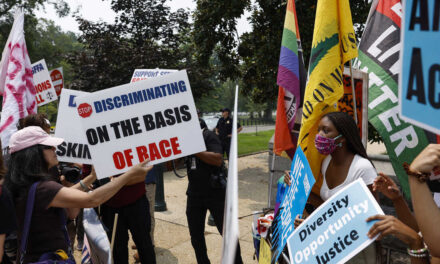
The Curious City podcast from member station WBEZ explores the Chicago roots of the legendary TV show Soul Train.
NATHAN ROTT, HOST:
The show “Soul Train” was broadcast nationally on TV from 1971 through 2006. And for years, it helped shape musical tastes all across the country. But it began as a local TV show in Chicago. The Curious City podcast from member station WBEZ set out to explore the show’s origins. Here’s reporter Arionne Nettles.
ARIONNE NETTLES, BYLINE: “Soul Train,” the place of love, peace, and, of course, soul, was one of the longest-running TV shows in history.
(SOUNDBITE OF ARCHIVED RECORDING)
UNIDENTIFIED PERSON #1: The Soul Train.
NETTLES: It was broadcast nationally for decades, from the ’70s through the early 2000s. And everyone knows the ever-so-cool Don Cornelius, the show’s creator and longtime host.
(SOUNDBITE OF TV SHOW, “SOUL TRAIN”)
DON CORNELIUS: Hey now, and welcome aboard. I can guarantee you’ll enjoy the ride, especially if you like your soul ice cold, because none other than the Ice Man himself is going to be looking you right dead in your eyes.
NETTLES: But before that, it started here in Chicago.
DEBBIE ARROYO: There are about 10 of us that were in high school together, and we all went together.
LARRY ARROYO: You cut school, didn’t you?
D ARROYO: We cut school in the afternoon to get downtown.
NETTLES: That’s Curious City listener Larry Arroyo (ph) and his mom, Debbie (ph).
D ARROYO: Yeah, and I got grounded when I got home.
L ARROYO: (Laughter) Showed up on TV. What do you expect?
NETTLES: Larry wrote to us to learn more about that earliest period of “Soul Train” that a lot of people don’t know about – when it began here in Chicago. And at that time, his mom and her friends weren’t the only ones cutting school.
RICHARD STEELE: I mean, these kids were, like, dying to be on television, show their dancing skills and be there on “Soul Train” with Don Cornelius.
UNIDENTIFIED PERSON #2: I remember the Big Apple hats and the dancing and the bell-bottom pants.
UNIDENTIFIED PERSON #3: You also had to go home. You had to change your clothes. You had to make sure your hair was looking right. You had to make sure your makeup was – so, yeah, it was a big deal.
NETTLES: I’m Arionne Nettles, and we’re going to tell the story of how our city gave birth to…
(SOUNDBITE OF TV SHOW, “SOUL TRAIN”)
UNIDENTIFIED PERSON #4: The hippest trip in America.
(SOUNDBITE OF MUSIC)
NETTLES: Going to “Soul Train” in the 1970s – a very big deal. Hair done? Check. Outfit looking right? Check. Crew assembled? Check and check. If you go down to the Chicago Board of Trade Building today, you’ll see people with their work bags and suits scurrying to and from their nine-to-fives. But back on August 17, 1970, this place looked very different. Young people were lined up around the block to be part of the first airing of this new dance show.
(SOUNDBITE OF TV SHOW, “SOUL TRAIN”)
CORNELIUS: Hi there, and welcome aboard. You’re right on time for a beautiful trip on the Soul Train. If the sight and sound of soul is your pleasure and what you treasure, you can bet your bottom we got them, baby. And after a message from the Johnson Products Company, three of the most beautiful and talented sisters you’ve ever seen in your life are going to be looking you dead in your eyes, where your beauty lies.
NETTLES: That’s the sound of the nationally syndicated show. We couldn’t get a hold of any tape from the inaugural year. Folks who worked on the show say tape was really expensive back then, and the show was likely taped over. Anyway, they packed the tiny studio, along with mostly Black creatives who were invited to showcase their talents on TV. Artist Michael Griffin was one of those creatives.
MICHAEL GRIFFIN: I do remember it broadcasting out there because I think right next to there was another place that we used to all go and hang out in called The Bull and the Bear, which was a after-work club and one of the buildings next to the Board of Trade, but down in the basement.
NETTLES: Michael was part of a group of designers and models named Les Menage. They were cool, popular, on the scene. So it’s not really a surprise that he’d be tapped to come on the show in those early years because, after all, that’s how it went.
GRIFFIN: I was known as a good dancer and someone who dressed well, which is kind of how those friendships began. And that happened for us. And our group was pretty much well known in the Chicagoland area.
NETTLES: That’s how he got to know Clinton Ghent, a dancer and choreographer. Ghent grew up with Don Cornelius, and Don tasked him with finding people for the show. Ghent invited them onto “Soul Train” to model their clothing designs.
GRIFFIN: I did watch the show when it first aired, and it was interesting because there was nothing else on TV that show Black dancers playing all Black music.
NETTLES: Most of us know the big story of “Soul Train” – how it moved to LA, all the major stars that would come through. But before all of that, before all that Hollywood glam, “Soul Train” looked, felt and sounded like the soul of Chicago.
(SOUNDBITE OF TV SHOW, “SOUL TRAIN”)
CORNELIUS: All righty, let’s check out that Soul Train line now. The Soul Train gang to the music of Earth, Wind & Fire and “Mighty Mighty.”
NETTLES: Ericka Blount Danois is the author of a book about “Soul Train” titled “Love, Peace and Soul.” She says the show allowed the city’s young people, like Michael Griffin, to become the show’s stars. And that was part of the magic.
ERICKA BLOUNT DANOIS: It was in this small space – like, 10 by 10, like, no air conditioning. But these kids were so talented that it took off. And also just being able to sort of see, you know, yourself on TV, like, you felt – you know, the kids felt like they were local celebrities because they were.
NETTLES: But let’s step back for a second.
(SOUNDBITE OF TAPE REWINDING)
NETTLES: Don Cornelius didn’t just show up at a TV station one day. He started out as a Chicago cop. Legend has it he was discovered by an executive at radio station WVON during a traffic stop. The exec was blown away by Don’s voice and suggested he get into radio. From there, Don’s career took off.
(SOUNDBITE OF ARCHIVED RECORDING)
CORNELIUS: Let’s get into trouble, baby.
NETTLES: Now, the idea of a dance show wasn’t necessarily new. So when Don Cornelius pitched his idea, people didn’t take it seriously at first because there were other shows in Chicago. But Don was motivated. He wanted to show Black youth in a way that the national media wasn’t portraying them at the time. His idea was to reimagine what a dance show could be – make it fresher, edgier, cooler, like him. And pairing the city’s young people with that vision proved to be a winning formula.
DANOIS: The other part was, you know, Don Cornelius’ vision as it related to having this kiddie show that was, I guess, a little bit more edgy than what was already happening. There was – there were two other dance shows – “Kiddie A Go Go” and “Red Hot And Blue.” But this dance show that he created on WCIU Channel 26 was a little bit edgier. These were teenagers a little bit older, and they had dance moves that were – you know, they were good.
NETTLES: On top of this, Chicago itself was already a music city, especially for Black musicians. Just think about some of the most popular music of the ’50s and ’60s, leading up to “Soul Train” in 1970, and where it came from.
DANOIS: So you’re talking about, like, Chess Records. You’re talking about, you know, blues artists – Etta James, Muddy Waters, Dells, Chuck Berry – you know, all of these people in this sort of place that is not New York, but is a music town. You know, Earth, Wind & Fire, Curtis Mayfield – you know, in terms of businesses also, you know, Sam Cooke creating his own label.
(SOUNDBITE OF SONG, “TWISTIN’ THE NIGHT AWAY”)
SAM COOKE: (Singing) They’re twisting, twisting. They’re twisting the night. Let’s twist a while. Lean up…
NETTLES: But for a cool cat like Don to be able to raise his profile, to be able to get all of the influencers and young people needed to pull this off all at the same time, it took Don Cornelius’ role as a Black radio personality because that helped push him into celebrity. And as migration to Chicago from the South continued during this time, communities of Black folks who love their radio personalities continued to swell.
MELODY SPANN COOPER: Here’s what you got to understand. Chicago was the Mecca.
NETTLES: That’s Melody Spann Cooper, the chair and CEO of the company that owns WVON. The station was the first in Chicago to cater to Black audiences.
(SOUNDBITE OF MONTAGE)
UNIDENTIFIED PERSON #5: Sound of WVON.
UNIDENTIFIED PERSON #6: More music.
UNIDENTIFIED PERSON #7: WVON Cicero.
MARTIN LUTHER KING JR: I do believe we shall overcome.
UNIDENTIFIED PEOPLE: (Singing) WVON.
NETTLES: Her father, Pervis Spann, was one of the city’s most well-known names in radio, as well as the station’s co-owner. So she grew up seeing Don Cornelius at work, and she saw the influence the station’s Black radio personalities had.
SPANN COOPER: And they all had monikers. You had E. Rodney Jones, the Mad Lad – right? – who was the program director.
(SOUNDBITE OF ARCHIVED RECORDING)
JIM MALONEY: Now from the home of The Good Guys, “The E. Rodney Jones Show.”
E RODNEY JONES: Welcome back, Jim. Hope you enjoyed your vacation, brother.
SPANN COOPER: You had Bernadine C. Washington. She had the biggest women’s club in Chicago – 3,000 women strong. But all of them had their own special identity, special brand and what they brought – their own DNA – which made it so powerful.
(SOUNDBITE OF ARCHIVED RECORDING)
UNIDENTIFIED PERSON #8: I’m 8 feet tall. I weigh 132 1/2 pounds – very slender and not really good looking either. But I do play some blast (ph) jams. There’s no two ways about that.
NETTLES: Radio personality Richard Steele may be retired, but his connections in Chicago radio still run deep. He worked at WVON with Don Cornelius, and they became friends around the time “Soul Train” was starting off. He says Don was ambitious and took full advantage of how well-loved WVON personalities were in the communities.
STEELE: WVON was the killer radio station at that point. And Don was a news guy who filled in as a disc jockey from time to time. Because WVON had such high visibility, it gave the personalities visibility, even the news people. So he had sets at high school. He had record hops in high schools, and he had a great deal of visibility.
NETTLES: In addition to radio, Don Cornelius was already connected to WCIU, the TV station where “Soul Train” would air, because he had a new show there.
STEELE: He did a show called “The Black’s View Of The News” that he did daily, and that’s how he really first connected with Channel 26.
NETTLES: At the time, the station was small. They were experimenting with programming and were open to allowing new show ideas, like those that appealed to specific demographics of viewers. Don used $400 of his own money to produce the pilot.
STEELE: When he came up with this idea for “Soul Train” locally, it became a success. I mean, the first people he had on were The Impressions.
(SOUNDBITE OF SONG, “WOMAN’S GOT SOUL”)
THE IMPRESSIONS: (Singing) She may not be the best looking woman I ever did see.
STEELE: Staple Singers – and these kids loved to dance. He had built up a following of these kids because of the high school hops he used to do. So this thing – this program after school with these kids dancing on television in Chicago, that was major. I mean, these kids were, like, dying to be on television, show their dancing skills and be there on “Soul Train” with Don Cornelius.
(SOUNDBITE OF SONG, “WOMAN’S GOT SOUL”)
THE IMPRESSIONS: (Singing) And all the love that I have belongs to the woman with soul.
NETTLES: “Soul Train” wasn’t the only show in the country, though. Every major metro area had a dance show with local teens clamoring to be on. But there was something about “Soul Train” and Don Cornelius that made this particular show stand out. Watching the show, he seemed so cool because he actually was.
STEELE: He was cool. He was cool. If you knew him, you wouldn’t say, oh, this is the erudite television personality who does – no, he’s Don from the hood. I always admired him ’cause he was cool. My thing was being cool. I had two people that I admired who were – Miles Davis, was one ’cause he was really cool.
UNIDENTIFIED PERSON #5: Yeah, he was.
STEELE: And Don Cornelius was the other one.
NETTLES: As a host, Don Cornelius’ connection with the audience was effortless, and it was authentic.
STEELE: With him, since he was from the inner city and from the community, he connected directly. He didn’t have to stretch to do that. He knew who everybody was, what they were about, as you do when you grow up in a community and you’re a person who’s involved a lot.
NETTLES: And it’s that culture, that Chicago cool, that took “Soul Train” far past the walls of its 10-by-10 studio. In 1971, just a year after being a local show, Cornelius got a syndication deal and created a new version of the show in Los Angeles. There, it became a national phenomenon. But it still remained a big deal in Chicago. And even today, you can still see its influence on the city’s culture.
ROTT: That was Arionne Nettles reporting for the Curious City podcast from WBEZ in Chicago. Each episode is based on questions from listeners. You can hear more of “Love, Peace And Soul Train” at wbez.org/curiouscity.
Copyright © 2023 NPR. All rights reserved. Visit our website terms of use and permissions pages at www.npr.org for further information.
NPR transcripts are created on a rush deadline by an NPR contractor. This text may not be in its final form and may be updated or revised in the future. Accuracy and availability may vary. The authoritative record of NPR’s programming is the audio record.




